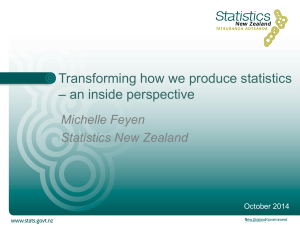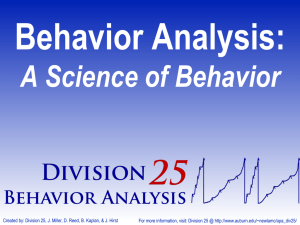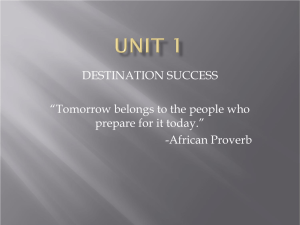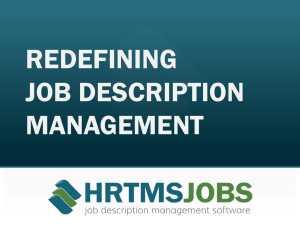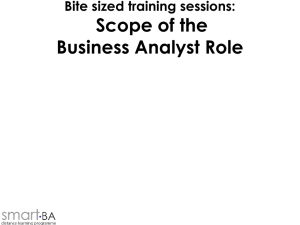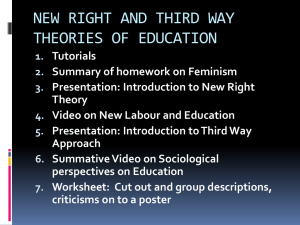Improving Requirements Management: Developing a Roadmap to
advertisement
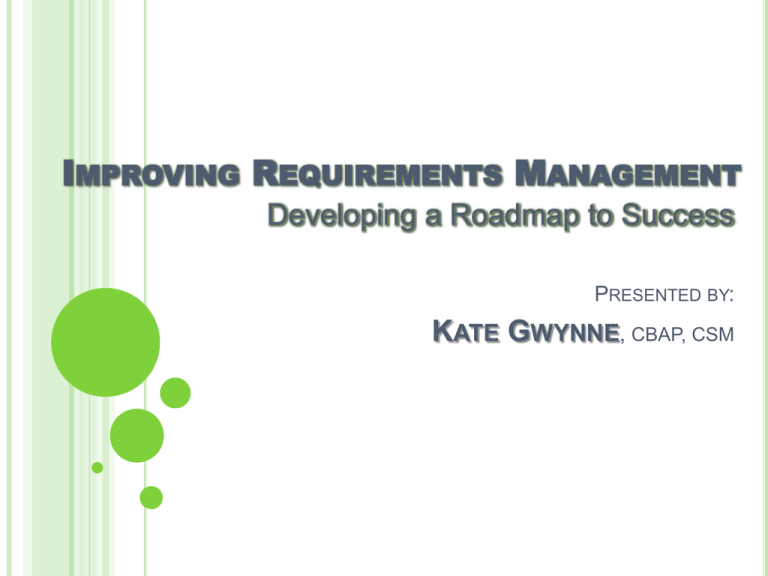
IMPROVING REQUIREMENTS MANAGEMENT Developing a Roadmap to Success PRESENTED BY: KATE GWYNNE, CBAP, CSM INTRODUCTION About . . . In 2008, Kate Gwynne became the Business Analysis Practice Lead at State Auto Insurance, after more than 20 years of experience helping organizations successfully align and implement their business and IT initiatives. As Practice Lead, she has developed and implemented various initiatives to help define, build, and guide the State Auto Analyst Community, including a Business Analysis Academy geared towards improving the knowledge and enhancing the skills of State Auto’s 120+ Analysts. As an industry leader, Kate has been a guest speaker at numerous industry and corporate conferences, including most recently: Baldwin-Wallace College and the 2012 IIBA Central Indiana Professional Development Day. 2 INTRODUCTION Duly Noted . . . While Kate, heretofore referred to as “Said Expert,” is employed at State Auto Insurance, furthermore and henceforth referred to as “Said Company,” the views and opinions expressed by Said Expert are not necessarily the views and opinions of Said Company. You can neither hitherto nor where-for-art-thou hold State Auto responsible for any comments hence forth. This presentation is an example of how implementing a requirements management program and best practices can improve aspects of projects. It is by no means prescriptive, nor does Said Expert promise that utilizing information in this presentation will be the sole variable that guarantees the success of your project. 3 AGENDA o o o o o Industry Statistics Requirements Management Current and Future State Roadmap to the Future Sustaining the Change INDUSTRY STATISTICS . . . 62 % Of projects . . . 5 Information obtained on industry websites such as CNet, Mindtools, and PMTips INDUSTRY STATISTICS . . . 62 % Of projects fail to meet their schedules 6 Information obtained on industry websites such as CNet, Mindtools, and PMTips INDUSTRY STATISTICS . . . Top 5 reasons. . . ? ? ? ? ? 7 Information obtained on industry websites such as CNet, Mindtools, and PMTips INDUSTRY STATISTICS . . . Top 5 reasons. . . Lack of stakeholder involvement Long or unrealistic time schedules Scope creep No change control system Missed, inaccurate, no requirements 8 Information obtained on industry websites such as CNet, Mindtools, and PMTips THE IMPACT OF MISSED AND INACCURATE REQUIREMENTS Analysis & Design Build Test Deploy & Support Orange = The Project phase in which defects are typically introduced Analysis & Design Build Test Deploy & Support Orange = The Project phase in which defects are typically discovered 9 * According to research performed by a national financial organization. THE COST OF MISSED AND INACCURATE REQUIREMENTS “…results show as much as a 200:1 cost ratio between finding and fixing errors before sign-off vs. finding and fixing requirements in the maintenance stages of the project.” * $$ $$ $ $ Analysis & Design Build Test Deploy & Support Analysis & Design Orange = The Phase in which Defects are Typically Introduced Build $$$$ $$$$ $$$$ $$$$ $$$$ $$$$ Test $$$$$$$$$$ $$$$$$$$$$ $$$$$$$$$$ $$$$$$$$$$ $$$$$$$$$$ $$$$$$$$$$ $$$$$$$$$$ $$$$$$$$$$ $$$$$$$$$$ $$$$$$$$$$ $$$$$$$$$$ $$$$$$$$$$ $$$$$$$$$$ $$$$$$$$$$ $$$$$$$$$$ $$$$$$$$$$ $$$$$$$$$$ $$$$$$$$$$ $$$$$$$$$$ $$$$$$$$ Deploy & Support Orange = The Phase in which Defects are Typically 10 Discovered $ = The Cost to Correct Mistakes * According to research performed by a national financial organization. 10 AGENDA o o o o o Industry Statistics Requirements Management Current and Future State Roadmap to the Future Sustaining the Change REQUIREMENTS MANAGEMENT IS . . . Planning & Monitoring Solution Assessment & Validation Analysis The activities that control requirements development, including requirements change control, requirements attributes definition, and requirements traceability. Elicitation Management & Communication 12 Benefits of Improving Requirements Management 13 Increases likelihood of achieving business value for chosen solutions Reduces project costs Expands Bandwidth Establishes Clear Expectations Benefits of Improving Requirements Management Increases speed to market Improves Estimates Reduces Scope Creep 14 AGENDA o o o o o Industry Statistics Requirements Management Current and Future State Roadmap to the Future Sustaining the Change 3 KEY COMPONENTS 1 2 3 16 3 KEY COMPONENTS People Process Technology 17 CURRENT STATE FUTURE STATE PEOPLE PEOPLE PROCESS PROCESS TECHNOLOGY TECHNOLOGY CURRENT STATE PEOPLE FUTURE STATE PEOPLE • Role descriptions are not consistent across the enterprise. • Not all Analysts have the necessary skills to meet the project objectives. PROCESS TECHNOLOGY PROCESS TECHNOLOGY CURRENT STATE FUTURE STATE PEOPLE PEOPLE • Role descriptions are not consistent across the enterprise. • Not all Analysts have the necessary skills to meet the project objectives. Roles and skills support project objectives. PROCESS PROCESS TECHNOLOGY TECHNOLOGY CURRENT STATE FUTURE STATE PEOPLE PEOPLE • Role descriptions are not consistent across the enterprise. • Not all Analysts have the necessary skills to meet the project objectives. PROCESS TECHNOLOGY Set Expectations Provide Education Roles and skills support project objectives. PROCESS TECHNOLOGY CURRENT STATE FUTURE STATE PEOPLE PEOPLE • Role descriptions are not consistent across the enterprise. • Not all Analysts have the necessary skills to meet the project objectives. PROCESS Set Expectations Provide Education Roles and skills support project objectives. PROCESS • Processes are not consistent across departments or like projects. • No way to measure process effectiveness. TECHNOLOGY TECHNOLOGY CURRENT STATE FUTURE STATE PEOPLE PEOPLE • Role descriptions are not consistent across the enterprise. • Not all Analysts have the necessary skills to meet the project objectives. Set Expectations Provide Education Roles and skills support project objectives. PROCESS PROCESS • Processes are not consistent across departments or like projects. • No way to measure process effectiveness. Processes are scalable, consistent, repeatable, effective, and welldocumented. TECHNOLOGY TECHNOLOGY CURRENT STATE FUTURE STATE PEOPLE PEOPLE • Role descriptions are not consistent across the enterprise. • Not all Analysts have the necessary skills to meet the project objectives. PROCESS Set Expectations Provide Education Align Requirements • Processes are not consistent across Activities with Project Objectives departments or like projects. Implement Best Practices • No way to measure process effectiveness. TECHNOLOGY Roles and skills support project objectives. PROCESS Processes are scalable, consistent, repeatable, effective, and welldocumented. TECHNOLOGY CURRENT STATE FUTURE STATE PEOPLE PEOPLE • Role descriptions are not consistent across the enterprise. • Not all Analysts have the necessary skills to meet the project objectives. PROCESS Set Expectations Provide Education Align Requirements • Processes are not consistent across Activities with Project Objectives departments or like projects. Implement Best Practices • No way to measure process effectiveness. TECHNOLOGY • Numerous tools used across organization. • Manual activities. • Too much / too little documentation. Roles and skills support project objectives. PROCESS Processes are scalable, consistent, repeatable, effective, and welldocumented. TECHNOLOGY CURRENT STATE FUTURE STATE PEOPLE PEOPLE • Role descriptions are not consistent across the enterprise. • Not all Analysts have the necessary skills to meet the project objectives. PROCESS Set Expectations Provide Education Align Requirements • Processes are not consistent across Activities with Project Objectives departments or like projects. Implement Best Practices • No way to measure process effectiveness. TECHNOLOGY • Numerous tools used across organization. • Manual activities. • Too much / too little documentation. Roles and skills support project objectives. PROCESS Processes are scalable, consistent, repeatable, effective, and welldocumented. TECHNOLOGY Consistent tools and templates support project objectives. Reporting enables decision making. CURRENT STATE FUTURE STATE PEOPLE PEOPLE • Role descriptions are not consistent across the enterprise. • Not all Analysts have the necessary skills to meet the project objectives. Set Expectations Provide Education PROCESS Align Requirements • Processes are not consistent across Activities with Project Objectives departments or like projects. Implement Best Practices • No way to measure process effectiveness. PROCESS Processes are scalable, consistent, repeatable, effective, and welldocumented. TECHNOLOGY TECHNOLOGY • Numerous tools used across organization. • Manual activities. • Too much / too little documentation. Roles and skills support project objectives. Provide Accelerators Consistent tools and templates support project objectives. Reporting enables decision making. AGENDA o o o o o Industry Statistics Requirements Management Current and Future State Roadmap to the Future Sustaining the Change Baseline Current State Requirements Management Roadmap People: • Role descriptions are not consistent across the enterprise. • Not all Analysts have the necessary skills to meet the project objectives. Desired Future State People: Step 3 examples: Automation • • • Process: Automate manual activities Provide reports linking initiatives to strategic objectives Trace requirements from problem identification to solution development and implementation and finally to business satisfaction with implemented solution Step 2 examples: Training Program • Processes are not consistent across departments or like projects. • No way to measure process effectiveness. Step 1 examples: Requirements Mgmt Framework Technology: • • Numerous tools used across organization. • Manual activities. • Too much / too little documentation. • • • • • • • Develop training and coaching program Update role descriptions so skills required match project demands Establish and implement knowledge sharing opportunities Coordinate advisory group or steering committee to provide guidance and perspective Develop communication plan Establish scalable requirements mgmt framework Determine input / output to external and internal processes and methodologies Create document repository for templates, training materials, and job aides • Roles and skills support project objectives. Process: • Processes are scalable, consistent, repeatable, effective, and welldocumented. Technology: • Consistent tools and templates support project objectives. • Reporting enables decision making. 29 MEASURING SUCCESS AUTOMATE MANUAL ACTIVITIES Goals: Reduce time to create test cases by integrating requirements management tool with QA team’s testing tool. Measuring Success: Baseline is 30 minutes per test case on current projects for QA team to manually develop test cases. Establish reports that track time from completed/approved requirements to test case development. REQUIREMENTS MANAGEMENT ROADMAP TIMELINE Milestones Automation Training Program Requirements Mgmt Framework Steps • • • • • • • • • • • Coordinate advisory group or steering committee to provide guidance and perspective Develop communication plan Establish scalable requirements mgmt framework Determine input / output to external and internal processes and methodologies Create document repository for templates, training materials, and job aides Develop training and coaching program Update role descriptions so skills required match project demands Establish and implement knowledge sharing opportunities Automate manual activities Provide reports linking initiatives to strategic objectives Trace requirements from problem identification to solution development and implementation and finally to business satisfaction with implemented solution 2012 Q2 Q3 2013 Q4 AGENDA o o o o o Industry Statistics Requirements Management Current and Future State Roadmap to the Future Sustaining the Change MANAGING CHANGE Hurdle #1 Hurdle #2 33 MANAGING CHANGE Resistance to Change Not managing the People side of change 34 SUSTAINING THE CHANGE Provide a culture of continuous change Define how success will be measured Encourage idea exchange for ways to improve Communicate with perspective and transparency Be a change leader Learn from the past, be in the present, live for the future Be fueled by passion and inspire passion in others Be self-motivated Take time to understand people Develop strong communication skills Be committed to continuous improvement 35 THANK YOU! Please feel free to contact me at: Kate.Gwynne@StateAuto.com or Kgwynne@hotmail.com 36
